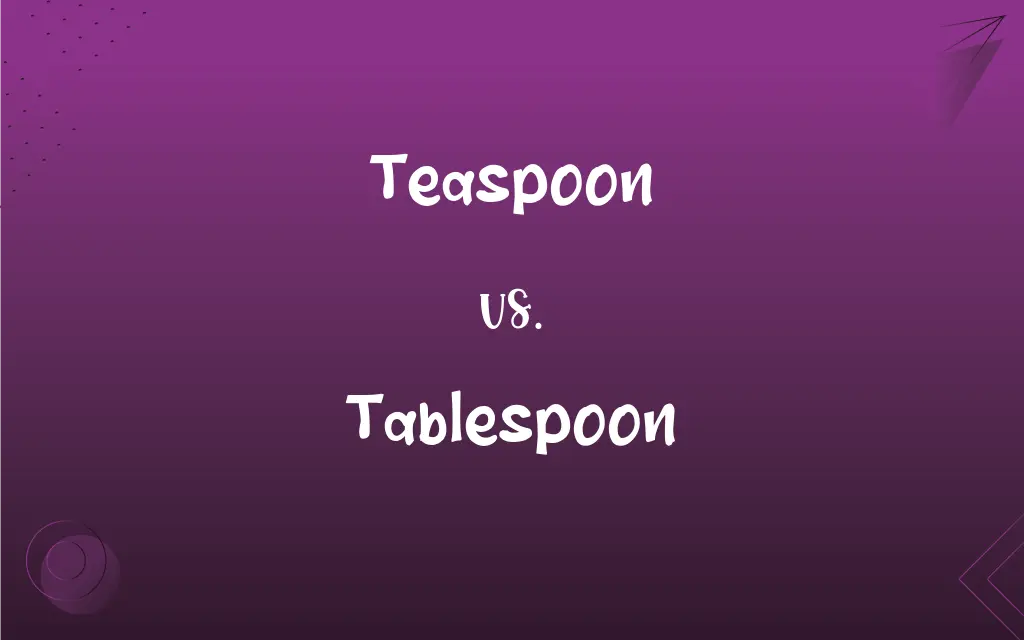Teaspoon vs. Tablespoon: What's the Difference?
Edited by Janet White || By Harlon Moss || Updated on May 30, 2024
A teaspoon (tsp) is a smaller unit of measure equal to about 5 milliliters, whereas a tablespoon (tbsp) is a larger unit, approximately 15 milliliters, commonly used in cooking and baking.

Key Differences
Teaspoon and tablespoon are both units of measure used primarily in cooking and baking to dose ingredients accurately. The teaspoon, abbreviated as "tsp", is the smaller of the two, while the tablespoon, "tbsp", is notably larger, and often used to measure both wet and dry ingredients.
A common adage heard in kitchens is that it takes three teaspoons to make a tablespoon. This ratio is fundamental to ensure precise measurements and to facilitate conversions between the two units when following a recipe, as respecting ingredient proportions is pivotal.
Teaspoons and tablespoons also take physical form as utensils in our kitchens. These utensils align with the measurements they represent. A teaspoon is a smaller spoon, often used to stir beverages like tea and coffee, aligning with its name’s origin. Conversely, a tablespoon, due to its larger size, serves versatile purposes, such as mixing ingredients, serving food, and even eating. This utensil is not solely confined to the preparation phase but plays a role in the consumption phase of meals as well.
Missteps in choosing between a teaspoon and tablespoon can affect the outcome of a dish. Using a tablespoon when a teaspoon is called for triples the quantity, which can disproportionally intensify flavors, alter textures, and potentially jeopardize the dish.
Comparison Chart
Volume
Smaller (5 mL)
Larger (15 mL)
ADVERTISEMENT
Common Abbreviation
Tsp
Tbsp or Tblsp
Usage Context
Often for smaller ingredient quantities
Commonly for larger or main ingredient quantities
Utensil Size
Smaller
Larger
Culinary Outcome Impact
Less significant when misused
Can significantly alter a dish if misused
Teaspoon and Tablespoon Definitions
Teaspoon
A small spoon typically used to stir hot beverages.
She stirred her coffee with a teaspoon.
ADVERTISEMENT
Tablespoon
A larger spoon used for serving or eating.
He served himself a heaping tablespoon of mashed potatoes.
Teaspoon
A unit of measure in cooking, equal to 5 milliliters.
Add a teaspoon of salt to the broth.
Tablespoon
A cooking measure of volume, usually equivalent to 15 milliliters.
She added a tablespoon of olive oil to the pan.
Teaspoon
A general term denoting a small, manageable quantity.
Just a teaspoon of sugar is enough for my tea.
Tablespoon
An expression to indicate a notable, but not excessive, quantity.
A tablespoon of humor can lighten any conversation.
Teaspoon
A slight but noticeable amount in a context.
He added a teaspoon of sarcasm to his response.
Tablespoon
A significant and often necessary amount in various contexts.
His plan needed a tablespoon of courage to execute.
Teaspoon
A small, often ornamental spoon used for serving.
She used a silver teaspoon to serve the caviar.
Tablespoon
A unit to casually quantify a generous amount of something.
The novel adds a tablespoon of mystery to the plot.
Teaspoon
The common small spoon used especially in serving and consuming tea, coffee, and desserts.
Tablespoon
A large spoon for serving food.
Teaspoon
Abbr. t or tsp. A household cooking measure equal to 1/3 tablespoon (about 5 milliliters). See Table at measurement.
Tablespoon
Abbr. T or tbs. or tbsp. A household cooking measure equal to 3 teaspoons, or 1/2 fluid ounce (15 milliliters). See Table at measurement.
Teaspoon
A small spoon used to stir the contents of a cup or glass.
Tablespoon
A large spoon, used for eating food from a bowl.
FAQs
Can I use a regular spoon as a tablespoon or teaspoon?
Regular spoons may lack standardization, risking measurement accuracy, and hence it’s prudent to use measuring spoons.
What is a teaspoon?
A teaspoon is a unit of measure equaling about 5 milliliters, often used in cooking, and is also a small spoon.
Why are teaspoons and tablespoons vital in cooking?
Teaspoons and tablespoons ensure precise ingredient measurements, impacting the flavor and success of dishes.
What is the abbreviation for teaspoon and tablespoon?
“Teaspoon” is abbreviated as “tsp,” while “tablespoon” can be abbreviated as “tbsp” or “Tblsp.”
Is it possible to measure tablespoons using a scale?
Yes, considering that ingredient densities vary, scales can provide accurate weight equivalents for tablespoons.
How to distinguish between a teaspoon and a tablespoon physically?
Physical spoons mirror their measurement counterparts; tablespoons are larger than teaspoons.
Can I measure non-culinary items with these spoons?
Yes, teaspoons and tablespoons can measure anything, but they’re specifically calibrated for culinary use.
Can I purchase these spoons individually?
Yes, teaspoons and tablespoons can be bought as sets or individually in various stores.
Can I substitute teaspoons and tablespoons?
Yes, 3 teaspoons equal 1 tablespoon, but ensure accurate conversions to maintain recipe integrity.
Can misusing teaspoons and tablespoons affect a recipe?
Absolutely, incorrect measurements can imbalance flavors and alter dish outcomes.
How does a tablespoon differ from a teaspoon?
A tablespoon, typically about 15 milliliters, is larger than a teaspoon and serves for measuring larger quantities in culinary contexts.
Are there different types of tablespoons and teaspoons?
Yes, these can be made from various materials like plastic and metal, and might have design variations.
How to measure half or quarter measurements with them?
Use designated half or quarter measuring spoons, or estimate using existing teaspoons and tablespoons.
How are these spoons made?
Teaspoons and tablespoons can be crafted from materials like stainless steel, plastic, or wood through molding or shaping processes.
How do I keep my measuring spoons clean?
Hand wash or place in a dishwasher, ensuring no residue remains to impact subsequent measurements.
How do I store teaspoons and tablespoons?
Storage preferences vary, but keeping them nested in a drawer or hung for easy access is common.
Do other countries use teaspoons and tablespoons for measurements?
Yes, though the exact volume might slightly vary in different countries or culinary traditions.
Why are they named teaspoons and tablespoons?
Their names likely originate from their initial uses: teaspoons for stirring tea and tablespoons for serving at tables.
Can using too many tablespoons ruin a dish?
Yes, overusing an ingredient, measured in tablespoons, can overpower a dish’s balance and flavor.
Are teaspoons and tablespoons used in professional kitchens?
Yes, professionals use them for accurate measurements to maintain consistency in dishes.
About Author
Written by
Harlon MossHarlon is a seasoned quality moderator and accomplished content writer for Difference Wiki. An alumnus of the prestigious University of California, he earned his degree in Computer Science. Leveraging his academic background, Harlon brings a meticulous and informed perspective to his work, ensuring content accuracy and excellence.
Edited by
Janet WhiteJanet White has been an esteemed writer and blogger for Difference Wiki. Holding a Master's degree in Science and Medical Journalism from the prestigious Boston University, she has consistently demonstrated her expertise and passion for her field. When she's not immersed in her work, Janet relishes her time exercising, delving into a good book, and cherishing moments with friends and family.






































































